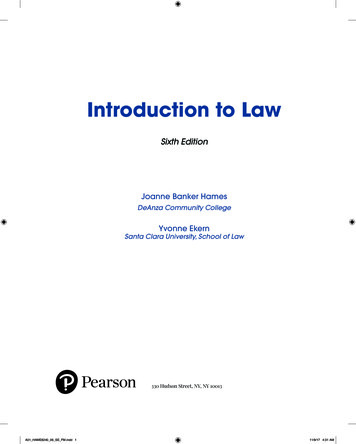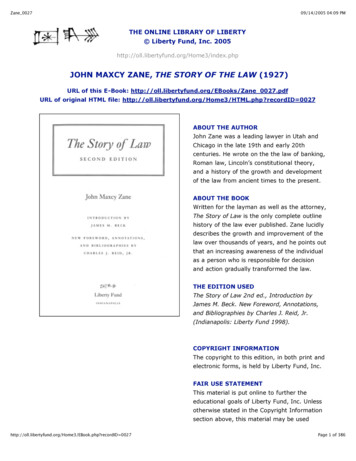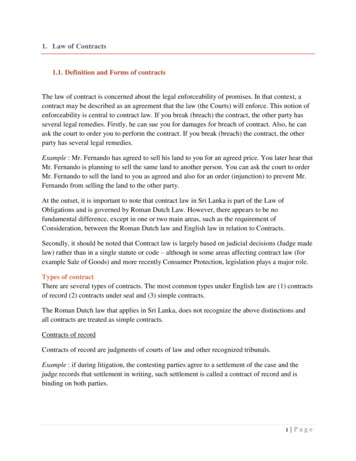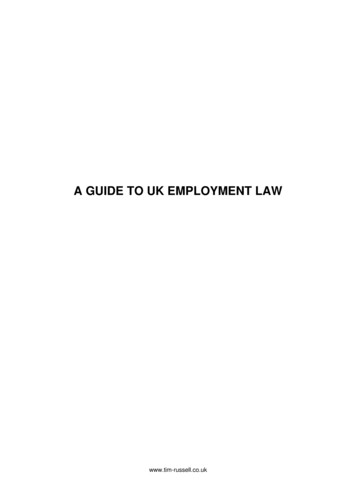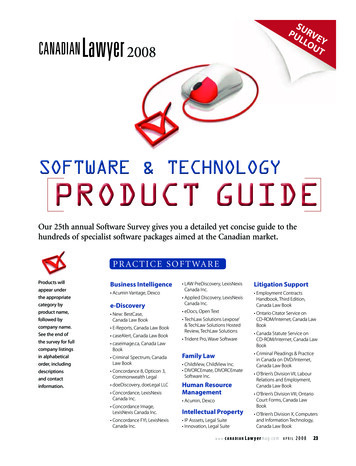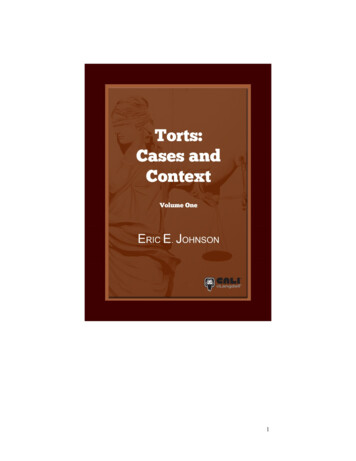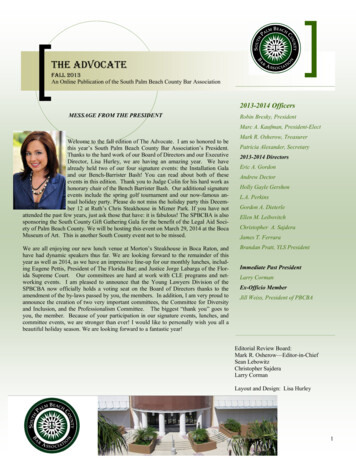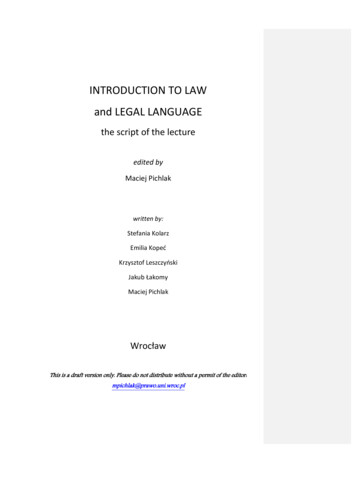
Transcription
INTRODUCTION TO LAWand LEGAL LANGUAGEthe script of the lectureedited byMaciej Pichlakwritten by:Stefania KolarzEmilia KopećKrzysztof LeszczyńskiJakub ŁakomyMaciej PichlakWrocławThis is a draft version only. Please do not distribute without a permit of the editor:mpichlak@prawo.uni.wroc.pl
PrefaceThe script we are presenting is an outcome of a cooperation of representatives of variousgroups of academic community who have met each other at the Faculty of Law,Administration and Economics at the University of Wrocław. These were students attending alecture on Introduction to Law, PhD students from the Department of Legal Theory andPhilosophy of Law, and the author of these words who is a fellow in the Departmentmentioned above. When teaching the course on Introduction to Law I saw ever more clearlythe need for a written exposition of presented issues. During lectures, as well as in workingclasses (taught by my colleagues from the Department) we were finding as highly problematicthe lack of a book which would expose in a coherent and compact manner content matterscomparable with those forming a Polish Wstęp do prawoznawstwa course. I hope that thepresented book will be helpful for students studying these issues – not only in the frames ofIntroduction to law course, but also within other similar academic courses, as for instanceLegal Language or Law’s Encyclopedia.The script is very traditional in nature, for it was written in the way traditionally reserved forthis genre of study. The main part of the content was prepared by students, using their ownnotes from lectures, complemented with further discussions with the lecturer and individualreading. The final editorial interventions are of minimal scope, being limited to clarifyingsome more ambiguous parts or eliminating obvious mistakes. The advantage of that fact is,among others, that one can reasonably expect a coherency between a level of complexity ofthe book and this of students' perception.As one may notice, the book is also an outcome of a broad thought-exchange within anacademic community. Therefore it may be treated as an attempt to realize the ideals ofuniversity study, where the border between transferring knowledge and awaking for owninquiry often fades away. Personally, I may add that such an awaking inspires also the wakingperson to more careful listening to what is waking.Of course, all of this is not very pragmatic. But if this very way of understanding a universitygoes to the opposite direction then contemporarily dominant view on higher education, maybeit is even more needed.The detailed division of work is following: Stefania Kolarz has prepared chapters VI and VII.Emilia Kopeć is an author of chapters V and IX, and Krzysztof Leszczyński – chapters III andIV. Jakub Łakomy has written chapters II and X and he also suggested a magnificent place forour meetings on a well at the historic courtyard of Ossolineum. As for me, I have preparedchapters I and VIII and edited the whole of the book.I would like to express my gratitude to all the authors for our cooperation and inspiringdiscussions and wish all the Readers a fruitful reading.As the presented version is still a draft, I apologize for all possible material and/or editorialmistakes; I also ask for not distributing it without my permit.Maciej Pichlak
WstępSkrypt, który przedstawiamy, jest efektem współpracy przedstawicieli rożnych grupwchodzących w skład społeczności akademickiej, którzy spotkali się na Wydziale Prawa,Administracji i Ekonomii Uniwersytetu Wrocławskiego: studentów będących słuchaczamiwykładu Introduction to Law, doktorantów w Katedrze Teorii i Filozofii Prawa tegożWydziału oraz niżej podpisanego, będącego pracownikiem we wspomnianej Katedrze.Prowadząc zajęcia z przedmiotu Introduction to Law coraz wyraźniej dostrzegałem potrzebępisemnego wykładu omawianych zagadnień. Zarówno podczas wykładu, jak i ćwiczeń(prowadzonych przez moje koleżanki i kolegów z Katedry) doświadczaliśmy brakuopracowania, które w spójny i przystępny sposób prezentowałoby treści porównywalne ztradycyjnym polskojęzycznym kursem ze Wstępu do prawoznawstwa. Mam nadzieję, żeniniejsze opracowanie może służyć jako realna pomoc dla studentów w tym zakresie.Skrypt ten ma bardzo tradycyjny charakter – powstał bowiem w sposób tradycyjniezastrzeżony dla opracowań określanych tym właśnie mianem. Przeważająca część tekstunapisana została przez studentów, na podstawie własnych notatek z wykładów, uzupełnionychpóźniejszymi dyskusjami z wykładowcą oraz indywidualną lekturą. Końcowe zmianyredakcyjne miały zakres minimalny, ograniczając się do doprecyzowania niektórych bardziejniejednoznacznych ustępów czy usunięcia ewidentnych pomyłek. Ma to i tę zaletę, żeuprawdopodabnia zgodność poziomu merytorycznej złożoności tej książki z poziomemstudenckiej percepcji.Jest zatem skrypt ten jednocześnie wynikiem szerokiej wymiany myśli w łonie akademickiejspołeczności. Tym samym może być poczytany za próbę urzeczywistniania ideałówkształcenia uniwersyteckiego, w ramach którego dochodzi do zatarcia granicy międzyprzekazem wiedzy a budzeniem do własnych dociekań naukowych. Od siebie dodać mogę, żetakie budzenie inspiruje także budzącego do uważniejszego wsłuchania się w to, co budzące.Oczywiście nie jest to zbyt pragmatyczne. Ale jeśli takie właśnie rozumienie uniwersytetuidzie w kierunku przeciwnym do dominującego obecnie trendu w szkolnictwie wyższym,może tym bardziej jest nam ono potrzebne.Szczegółowy podział prac przedstawia się następująco: Stefania Kolarz przygotowałarozdziały VI i VII. Autorstwa Emilii Kopeć pozostają rozdziały V i IX, a KrzysztofLeszczyński – rozdziały III i IV. Jakub Łakomy jest autorem rozdziałów II i X, a takżepomysłodawcą wspaniałego miejsca dla naszych spotkań przy studni na historycznymdziedzińcu Ossolineum. Niżej podpisany przygotował rozdziały I oraz VIII, a także dokonałredakcji całości.Dziękując wszystkim autorom za współpracę i inspirujące dyskusje, życzę Czytelnikomudanej lektury. Jako że prezentowana wersja ma wciąż charakter roboczy, przepraszam zawszelkie możliwe niedociągnięcia merytoryczne czy edytorskie; proszę również onierozpowszechnianie jej bez mojej zgody.Maciej Pichlak
ContentPreface. 2Wstęp . 3Chapter I The Legal Concept of Law . 61. Four approaches to the law. 62. Legal system and legal order . 73. Three levels of the law . 10Chapter II Basic Philosophical Conceptions of Law . 121. Natural law . 122. Legal positivism . 133. Legal realism . 14Chapter III Validity and legitimacy of law . 171. Four conceptions of validity . 172. Internal and external point of view . 193. The concept of legitimacy . 19Chapter IV The norm from the linguistic point of view . 221. Basic functions of utterance . 222. Kinds of directives . 233. Conventional act . 244. Legal norm as a speech act. 255. The role of structural and contextual factors in deciding the status of utterance . 256. The structure of legal norm . 26Chapter V Types of norms . 27Introduction. 271. General and individual norm . 273. Ius cogens and ius dispositivum . 284. Rules and principles. 285. Policies . 30Chapter VI Legal Provisions . 311. The concept of legal provision; difference between norm and provision . 312. Selected types of legal provisions . 31Chapter VII Legal System . 351. The notion of a legal system. 352. Formal and material relations in legal system . 35
3. Postulates of legal system . 364. Loopholes in the law. 365. Collisions in the law . 376. The procedure of ‘weighing’. 387. Collision rules . 388. Branches of law . 399. Divisions within a legal system . 40Chapter VIII Legal Interpretation. 421. Introduction . 421. A division of interpretation according to the context. . 422. A division of interpretation according to the subject . 433. A division of interpretation according to the methods . 444. A division of interpretation according to the outcomes. . 46Chapter IX Legal Inference . 471. Introduction . 472. Logical inference. 482. Instrumental inference . 483. Axiological inference . 49Chapter X Law-Creating . 521. The concept of sources of law . 522. Basic forms of law-creating: legislation and practice. Characteristics of legislation . 523. Types and hierarchy of the sources of law . 534. Promulgation, abrogation, amendments . 555. Law-creating practice: customary law and case law . 556. Precendents de iure and de facto. 577. The structure of precedents . 58
Chapter IThe Legal Concept of Law1. Four approaches to the lawThe law is a fascinating phenomenon that surrounds us in almost every second of our life. Itaffects the way we act, the way we think and the way we perceive ourselves. As RonaldDworkin said: “We live in and by the law. It makes us what we are: citizens and employeesand doctors and spouses and people who owe things” (Law’s Empire, )But what the law is? The answer is far from being simple. Looking for the answer in books,Komentarz [p1]: Ronald Dworkin(1931 – 2013) –A north American legal philosopher,the author of so called 'interpretative'philosophy of law.we find a plenty of different viewpoints and narratives on the law over centuries. Even if welimit our investigation to the modern times, there is a number of different schools andintellectual perspectives and each of them presents its own standpoint in this debate.The dispute concerns not only a question 'what the law is?' but also 'where should we searchfor it?', that means, what kind of being the law is? To what sphere of reality does it belong or,to put it in other words, what is the ontological characteristics of law?We may distinguish four most influential approaches to the law in contemporary legalKomentarz [p2]: Ontology (from theGreek ontos – 'of that which is') –philosophy of being (that what is, reality)and it's nature.science (legal scholarship), based on different possible answers to the question posed above: alinguistic, an axiological, a psychological and a sociological approach.a) The linguistic approach perceives the law as a collection of linguistic acts (utterances).Komentarz [p3]: linguistic approach –see more in chapter IV.Such utterances are called norms or provisions. Legal norms are formulated in a specificlanguage (so termed ‘legal language'). The viewpoint that the law is first of all a linguisticphenomenon is the dominant one in the contemporary legal science. Also laymen usuallyunderstand the law as a system of norms or provisions.Linguistically oriented legal research distinguishes between two basic types of the legallanguage: a language of legal texts (law-making instruments), and a language of legal practiceand legal science. Nevertheless, the very distinction is not free of controversies, being moreclear in so called civil law systems and rather blur in legal systems of common law.b) The axiological approach perceives the law as an expression of values which usually areregarded as prior and independent from the law in their existence. This kind of approach istypical of philosophies of natural law, yet it is not limited to these. The dominant view inPolish legal science was for decades skeptical toward this approach, treating it as aconsequence of philosophical idealism (as opposite to materialism). This view is still widelyKomentarz [p4]: This distinction ismirrored in the Polish language by adifferentiation between terms ‘językprawny’ and ‘język prawniczy’, what ishardly translatable.Komentarz [p5]: Distinction betweencivil law and common law – see chapter VII.Komentarz [p6]: Axiology (from theGreek axios – worth, valuable): philosophyof values.Komentarz [p7]: Philosophy of naturallaw – see chapter II.Komentarz [p8]: Idealism – aphilosophical standpoint that affirms theobjective existence of values and othernon-material beings.
spread e.g. in numerous Polish textbooks for 'Introduction to the Law' courses. However,nowadays the very opposition between idealism and materialism in philosophy is questionedand we may observe the growing interest in axiological problems among legal scholars.c) The sociological approach conceives of the law as a social phenomenon. According to thisrelations or social institutions. This kind of approach is typical of so called legal realismKomentarz [p9]: Agent (in socialscience): an acting subject, a participant ofsocial practices.and is related to a distinction between 'law in books' (which is a matter of interest of linguisticKomentarz [p10]: legal realism - seechapter II.approach, the law might be understood as e.g. acts of social agents (social practices), socialapproach) and 'law in action' (how the law 'works' in the social reality).d) The psychological approach regards the law as a psychological phenomenon, existingfirst of all in human beings’ minds. There are more radical and modest versions of thisapproach. The former treat the law as a fiction, a kind of 'group illusion', whereas the latteradmit that it has some kind of objective existence but focus on the problem how such anobjectively existing law is mirrored by psychological process of human mind.Except the four approaches listed above we may distinguish others. Among them, two are themost influential in contemporary jurisprudence: economical and political approach. Bothinterpret the law as rather dependent and instrumental: the former in relation to economicalinterests and the latter to a (real or symbolic) power of some social groups or classes.Furthermore, it should be remembered that the above approaches might be merged together insomeone's actual – theoretical or practical – perspective. Thus we may meet e.g. a linguistic–sociological approach (theories of legal argumentation) or linguistic-axiological approach(legal hermeneutics, interpretative theory of law).In this book, in accordance with the dominant perspective in Polish jurisprudence, we shallchoose the linguistic approach as a basic one. Nevertheless, it will be often combined withsociological and axiological insights. Although this merely represents a typical viewpoint inour legal culture, it should be realized that this is not the only possibility – such a choice isnever neutral and may be disputable.2. Legal system and legal order
According to the linguistic approach we have chosen, the law is usually defined as a systemof valid norms: a legal system. Each word in this crude definition (system, norm, validity)begs for an explanation; we shall offer such in further chapters. For this moment, let us limitourselves to some preliminary remarks: the (legal) norm is a rule of conduct, that isKomentarz [p11]: legal system – seechapter VIIlegal norm – see chapters IV and Vvalidity – see chapter IIIreconstructed from texts of binding legal instruments; and the (legal) system is an organizedand internally coherent collection of such norms.The legal system, regarded this way, is created first and foremost by an official politicalauthority, that is a legislator, and is contained in legal texts issued by this legislator.Nevertheless, such a definition – equating the law with the totality of legal texts – is toonarrow. It simply does not cover everything what counts as the law.For this reason it is suitable to introduce also another concept: the concept of legal order. Thelegal order has broader scope than the legal system, since it includes also some extra-textual,not written rules and principles which are necessary for a proper understanding, interpretingand applying the law. While thinking about the law, legal professionals (lawyers) usually takeinto account also these extra-textual elements – even if they hardly ever do it consciously.While the legal system is rather 'flat' in nature, containing only one layer – the layer of normsreconstructed from legal texts – the legal order is best perceived as a multilayeredKomentarz [p12]: The term ‘legalprofessional’ means everyone who worksprofessionally with the law – that is judges,prosecutors, barristers, attorneys, etc. Theterm ‘lawyer’ in anglo-saxon countriestraditionally has a narrower scope. In spiteof this, for the sake of brevity, we shall usethem as synonymous.phenomenon. Below we present some theoretical attempts to capture this multilayered natureof the law.1) Ronald Dworkin, in his powerful critique of legal positivism, distinguished two kinds ofrules that are legally relevant: 'typical' rules and principles.a) Rules: may be found in legal texts and are valid due to the fact that they meet some formalKomentarz [p13]: legal positivism see chapter IIKomentarz [p14]: rules and principles– see more in chapter Vcriteria (termed by Dworkin ‘a test of pedigree'). These are legal rules in a positivistic sense.b) Principles: are not written in texts of law-making instruments, but are a part of'institutional morality'. They are basic moral principles, generally accepted in a particularlegal culture. Principles are valid not on the ground of formal but material criteria: theirpractical weight (significance) and institutional acceptance. Dworkin offers examples of suchprinciples, formulated explicitly in court decisions, e.g.: ‘No one should be allowed to profitfrom their own wrongdoing’.2) Also some versions of legal positivism acknowledge the multilayered nature of the legalorder. Herbert L.A. Hart, one of the most distinguished representatives of this school,offered an idea of law as a system of primary and secondary rules.Komentarz [p15]: Herbert L.A. Hart(1907-1992) – an English analyticalphilosopher, one of the most importantlegal philosophers in the XX century. Hisbook The Concept of Law (1961) is treatedas a founding act of a contemporary legalpositivism.
a) Primary rules are simple ‘duty-imposing’ rules (e.g. It is prohibited to: .cross the streeton the red light; .steal; .step into the sacred forest etc.).b) Secondary rules are ‘power-conferring’ rules what means that they do not just impose aduty to act in a certain way but they create a competence to take some actions of specialsignificance (conventional acts). According to Hart, we may distinguish three types ofKomentarz [p16]: Conventional act:see chapter IV.secondary rules: Rulesof change give an answer to a question how the system of primary rules may bechanged: new rules enacted and the old ones abrogated. Rulesof adjudication answer a question who possesses an authority to settle disputes as forapplication of primary rules. Rulesof recognition define the criteria under which other rules may be recognized aslegally valid (as a part of the legal system).It is remarkable that never all the secondary rules (and particularly the rules of recognition)may be written in legal texts. In other words, it is logically impossible to formally issue all therules belonging to the legal system. Some of them just work in practice, as a common butimplicit knowledge or a scheme of conduct.3) Zygmunt Ziembiński, another representative of legal positivism, claimed that in eachlegal order one may find ‘a normative conception of sources of law’ which answers thequestion ‘what count as the law?’ or ‘which specific legal norms belong to the legal system?’.Ziembiński distinguished three main components of such a ‘normative conception’:Komentarz [p17]: Zygmunt Ziembiński(1920-1996) – famous Polish legalphilosopher, representative of legalpositivism and analytical theory, the coauthor of derivational theory of legalinterpretation (see chapter IX) and atheoretical distinction between legalprovision and legal norm (see chapter VI).ideological foundation of the system, validation rules and exegesis rules.a) Ideological foundations of the system deliver an answer to a question about a politicalKomentarz [p18]: ideologicalfoundation of the system – see chapter III.sovereign and a legitimacy of the system as a whole.b) Validation rules define relevant sources of law – facts that result in creation of new legalrules (provisions). There are two basic groups of such facts, which allow to distinguish textualand non-textual sources of law.c) Exegesis rules regulate the process of ‘working’ with texts of law-making instruments;they allow for a reconstruction of a collection of legal norms from these texts. According toZiembiński, there is a further sub-division of these rules into three groups: interpretation rules,inferential rules and collision rules. We shall clarify each component of the normativeconception of sources of law in further chapters.Komentarz [p19]: validation rules –see chapter XIinterpretation rules – see chapter IXinferential rules – see chapter Xcollision rules – see chapter VII
3. Three levels of the lawOne of the most holistic theoretical representation of the multilayered nature of law is an ideaof three levels of law, offered by Kaarlo Tuori. Tuori’s theory treats on a modern legalsystem, particularly within the European legal culture, as a historic type of law. This is apositivistic theory in that sense that all three levels of law are created in and by some socialKomentarz [p20]: Kaarlo Tuori (born1948) – Finnish legal scholar, a professor ofUniversity of Helsinki. His researchinterests cover a legal theory,constitutionalism, and the European Unionlaw.practices – they are ‘positive’ that means: socially established rather than being inferred fromany ideal, metaphysical sources.The three levels of the law are: a surface level, a legal culture and a deep culture of the law.a) Surface level is the level of legal provisions formulated in law-making instruments andother ‘typical’ sources of law. This is the most intuitive, the most visible and the most obviouslayer of the law. But in the same time it is the most turbulent and unstable one. This layer ofthe law is created by a political legislator.b) As compared with the surface level, a legal culture is not only produced by acts of thelegislator, but it is also created by legal practice and legal scholarship. Tuori’s theory focuseson a professional legal culture (legal culture sensu stricto), as opposed to a legal culture ofthe whole society. The legal culture contains values, principles, and concepts which areanchored in beliefs and practices of the specific legal community. One may distinguish legalcultures of each nation state (like Polish, German, Spanish, Hungarian legal culture etc.),although cultures of different European countries show significant similarities to each other.On the other hand, within the one ‘state culture’ we may observe the sub-cultures of differentsocial groups (e.g. different legal professions – a legal culture of judges, of prosecutors etc.).Generally speaking, it is to be remembered that culture rarely is a homogenous phenomenon –different, and even contradictory elements may co-exist within one culture.Tuori distinguishes following components of the concept of legal culture: methodical elements (paths of legal reasoning and argumentation, e.g. rules of legalinterpretation, collision rules, argument a simili or a contrario) conceptual elements (basic legal concepts, e.g. a legal norm, a legal entity, privateand public law, a source of law etc.) normative elements (general legal principles, e.g. a presumption of innocence in acriminal law, lex retro non agit etc.) general doctrines (more comprehensive doctrines that bring a prima facie order inother components of legal culture, e.g. an accepted doctrine of sources of law,different theories of legal interpretation, a doctrine of human rights etc.)Komentarz [p21]: theories of legalinterpretation – see chapter IX
c) the deep culture of law is built by the most basic qualities of the law and the way it isperceived. These qualities are common for all modern legal cultures, thus allow to distinguishthe ‘modern’ law as a historic type of law. Clear enough, also other types of law possess theirown deep culture, which is characteristic of them and allow to distinguish each of them fromother historic types of law. The deep culture is usually unconscious, but at the same t
understand the law as a system of norms or provisions. Linguistically oriented legal research distinguishes between two basic types of the legal language: a language of legal texts (law-making instruments), and a language of legal practice and legal science. Nevertheless, the very distinction

